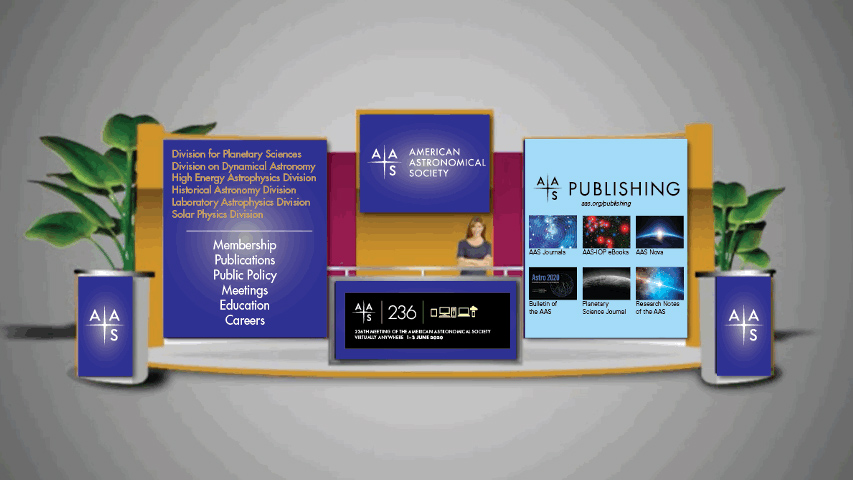How the AAS Will Organize a Virtual Scientific Conference

Kevin Marvel American Astronomical Society (AAS)
During the closing days of February, it became clear that the coronavirus was going to disrupt our lives — we just didn’t fully appreciate how significant the disruption would be. By 16 March all AAS staff who normally work in one of our office locations were instead working from home. By then officials in Wisconsin, where we’d been planning to hold our 236th meeting in Madison in early June, had declared a public health emergency and recommended against holding any large gatherings in the state. The AAS Board of Trustees necessarily voted to cancel our in-person meeting but challenged the Executive Office staff to convert it into a virtual one.
After the vote, I met with our team to outline what we wanted to accomplish. Our goal was to provide the same scientific value online as we do in person, with a focus on maximizing attendee engagement. We wanted to present quality content with high production values while enabling human connections among researchers. To make organization easier, we opted not to include so-called splinter meetings, gatherings held in conjunction with our conference but not part of the scientific program. For normal AAS conferences we help with the logistics of these side meetings to take advantage of so many scientists coming together in one place, to encourage greater attendance, and to assist our discipline, for example, by facilitating advisory-group meetings and multi-institutional collaboration meetings. But this would not be a normal conference, and there would be no coming together in one place.

Aside from having no splinter meetings, being trimmed from four days to three, and making a few other changes, our virtual AAS 236 will be an online version of our regular summer conference. We will experiment with some asynchronous content — such as our Virtual Open Mic Project (#OpenMicProject) — but the bulk of the meeting will be held synchronously (in real time), restricted to those who register (and pay a substantially lower fee than for an in-person meeting), and captured for later access by registrants who might have missed something in real time. As usual, recordings of the plenary talks will be made freely available to all AAS members soon after the conference and to the rest of the community roughly six months later.
Although some might argue that merely moving our regular conference content online doesn’t take full advantage of what the internet can offer, we have precious little time to prepare for and accomplish just the basics, let alone to experiment with substantially new modes of online interaction with which we have no experience. Assuming we succeed with this first virtual conference (and we do expect to succeed), we’ll have plenty of opportunities to “push the envelope” in the future.
Meeting Components
Here are the components of a regular summer AAS meeting that we decided to include in our virtual conference:
- Plenary Sessions: Invited & prize lectures of about 50 minutes’ length.
- Contributed Oral Sessions: Parallel 90-minute sessions of short talks, including dissertation talks, arranged thematically.
- Special Sessions: Single 90-minute sessions on specific topics, run in parallel with contributed oral sessions, proposed by members and approved by the AAS Vice-Presidents.
- Meetings-in-a-Meeting (MiMs): Same as Special Sessions, but with multiple 90-minute sessions, perhaps held across multiple days.
- Division Meetings: Scientific sessions organized and managed by one or more of the AAS Divisions — for AAS 236, the Laboratory Astrophysics Division (LAD).
- Poster Sessions: iPoster (digital interactive) contributed posters and iPoster-Plus presentations featuring short talks illustrated with iPosters, arranged thematically. (Note that we decided months ago that we would not have printed posters at AAS 236, only iPosters and iPoster-Plus presentations.)
- Town Halls: 1-hour presentations and Q&A with representatives of government agencies, space-science missions, ground-based observatories, and policy committees.
- Exhibit Hall: Space for exhibitors and sponsors to display products and information and to interact with conference attendees.
- AAS Members Meeting: An annual presentation and Q&A with officers and staff summarizing the Society’s finances and operations.
- Press Conferences: 1-hour presentations of newsworthy science results from the meeting enhanced with publication-quality graphics and other resources for reporters.
- Networking and professional-development opportunities.
Meeting Tools
We rapidly evaluated a wide range of possible technology solutions according to the following criteria:
- Service — vendor fully engaged and can support their product.
- Compatibility — accessible using various devices and operating systems.
- Innovation — open standards and future upgrades.
- Configuration — AAS brandable and configurable for our needs.
- Security — access controls as well as protection of member information.
- Performance — scalability, reliability, and cloud access.
- Reporting — real-time tracking and reports for analysis.
- Non-Proprietary — integrates with current and future tools, modular.
- Ease of Use — widely familiar, excellent user experience.
Here are the tools we've decided to use to implement our virtual AAS 236 (subject to change as we finalize our plans over the next month or so):
- Zoom Webinars
- Plenary Sessions
- Contributed Oral/Special/MiM/LAD Division Meeting
- Town Halls/Workshop(s)
- iPoster-Plus Sessions
- Press Conferences
- Zoom Meetings
- AAS Members Meeting
- iPosters with Chat
- iPoster Sessions
- vFairs
- Exhibit Hall
- Networking Lounge
Here are brief comments about some of these technology solutions:
Zoom Webinars
Zoom Webinars operate differently from Zoom Meetings, with which many of us are now intimately familiar. A “host” and a small number of “participants” control the meeting and give the presentations, while the “attendees” (from dozens to hundreds) are not seen, heard, or able to control anything or share their screens. Attendees may ask questions and respond to polls initiated and controlled by the host or participants. We will schedule the webinars and assign session chairs to serve as hosts.
Note: Security issues became apparent with Zoom shortly after its popularity soared early in the COVID-19 crisis. Some are easily addressed by following simple instructions on how to adjust the software’s settings. Others involve privacy concerns. Zoom is working feverishly to address all such issues, and we expect solutions to be available well before our virtual meeting occurs.
iPosters
The Society already has substantial experience using the iPoster solution provided by aMuze! Interactive, and we have found it effective and very popular, especially among early career members. Authors use standard templates to create a digital iPoster, which is then available online shortly before, during, and after the conference. Here's what the online iPoster gallery from last January's AAS meeting looks like:

iPosters can include audio narration; high-resolution, zoomable images; videos and animations; and text with (or without) embedded hyperlinks. In addition, iPosters include a "chat" feature that we haven’t needed before but will use now; it allows someone viewing an iPoster to interact in real time with the author. We plan to establish fixed times each day of the conference when iPoster authors will be encouraged to be available to receive and respond to chat communications, virtually replicating the morning and afternoon poster breaks we hold at regular in-person meetings.
Exhibit Hall
The exhibitors at AAS meetings include government agencies, ground-based observatories, space-astronomy missions, book and journal publishers, aerospace companies and consultants, and manufacturers and dealers of astronomical equipment and software — even clothing and jewelry. We have opted to use the vFairs platform for our virtual exhibit hall. It nicely replicates the “look and feel” of our regular in-person exhibit hall. Each “booth” allows custom branding and features a resource library with image and video product displays, downloadable brochures and documents, and other types of content. Here's what the AAS booth might look like:

In addition, with vFairs our exhibitors can make themselves available at particular times throughout the conference to engage in one-to-one conversations or group chats with attendees.
Next Steps
We are now working with the various software vendors to enable our virtual conference to take place. Registration is open through 29 May, and we are accepting abstracts through 14 April.
Although many of the costs of an in-person conference have gone away (e.g., venue rental, audio-visual equipment rental and setup, and catering), we still have to pay for our abstract system and the staff time needed to organize all the details of the meeting. We also have some new costs, chiefly the software licenses for the technology solutions described above. We’ve focused on providing the lowest registration rates possible to minimize the barrier to participation. By doing so, we hope that astronomers outside North America will choose to participate in the conference, something most would not have done in person.
The virtual meeting takes place 1-3 June; the science program will be published shortly, and we’ll soon begin scheduling online training for hosts and presenters. Keep your eye on the AAS 236 website for updates and other information.
Looking Ahead
The COVID-19 crisis presents grave challenges to how science normally proceeds. We value in-person interaction with our colleagues and enjoy the opportunity to catch up on the latest research. Without the ability to gather in person, we must find other ways to achieve the same results. Although we may not have a perfect solution in hand, we know we have a suite of technologies that will enable us to hold our first-ever virtual conference and deliver substantial value and engagement to all attendees. We will learn along the way and refine our knowledge, because we do not see this meeting as a one-off. The possibility that large gatherings will be limited until a coronavirus vaccine or other prevention is available is significant.
Adding some virtual features to our normal in-person conferences — something the AAS Sustainability Committee has been urging us to consider for some time — would accomplish numerous other positive results. First, it would remove the significant barrier of travel and lodging expenses. Second, allowing some fraction of conference participants to participate remotely would reduce our meetings’ carbon footprint, helping the environment. Finally, the online materials, especially the iPosters, could be accessed at participants’ convenience while still allowing interaction between authors and attendees.
We hope all our colleagues around the world remain healthy and engaged during this difficult time. Moving research forward under these circumstances is challenging at both the personal and institutional levels. Science, of all types, is fundamentally important to advancing human knowledge and is one of our highest callings as a species. We must facilitate that effort despite the challenges we face. The AAS will continue to publish our journals, assist our members, and seek to engage researchers through our conferences, whether virtual or in person.
I thank the AAS Board of Trustees and the AAS staff for their engagement and focus during this crisis, and for providing background material that helped inform this article.


